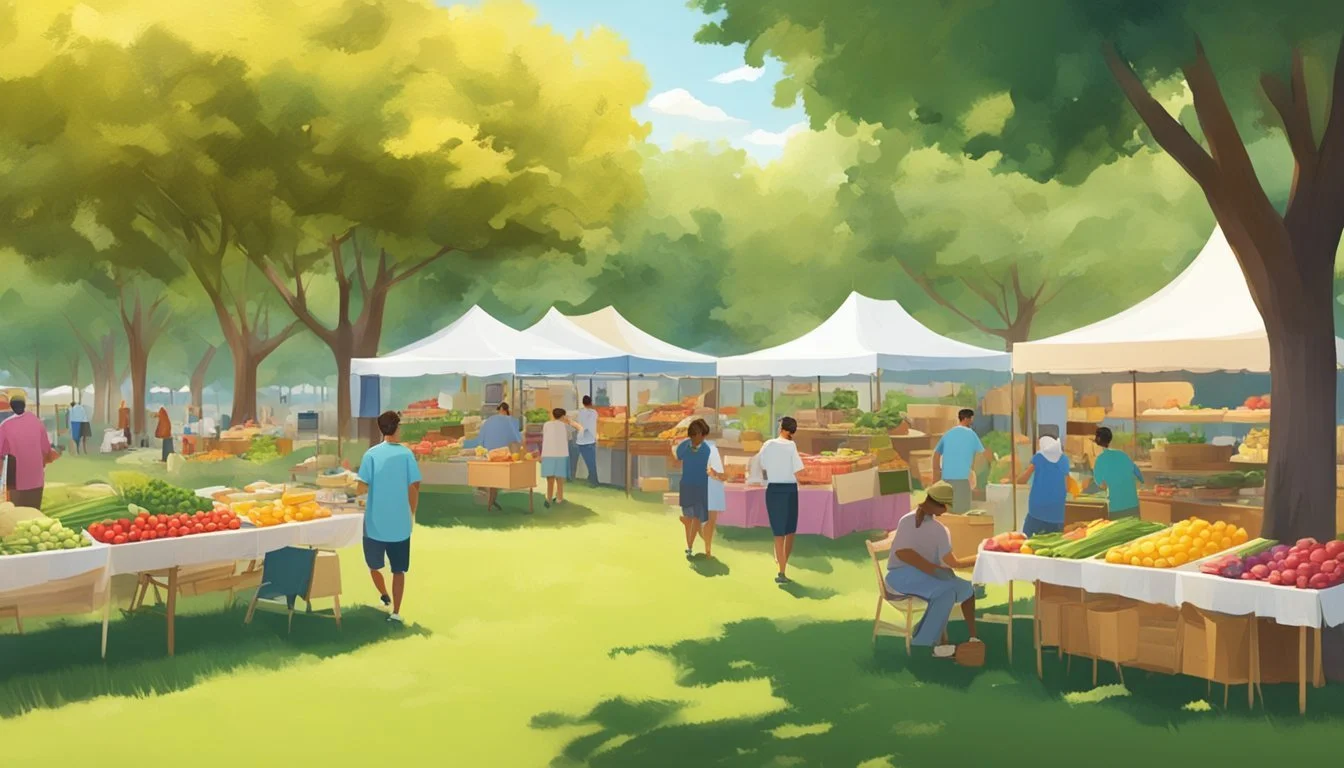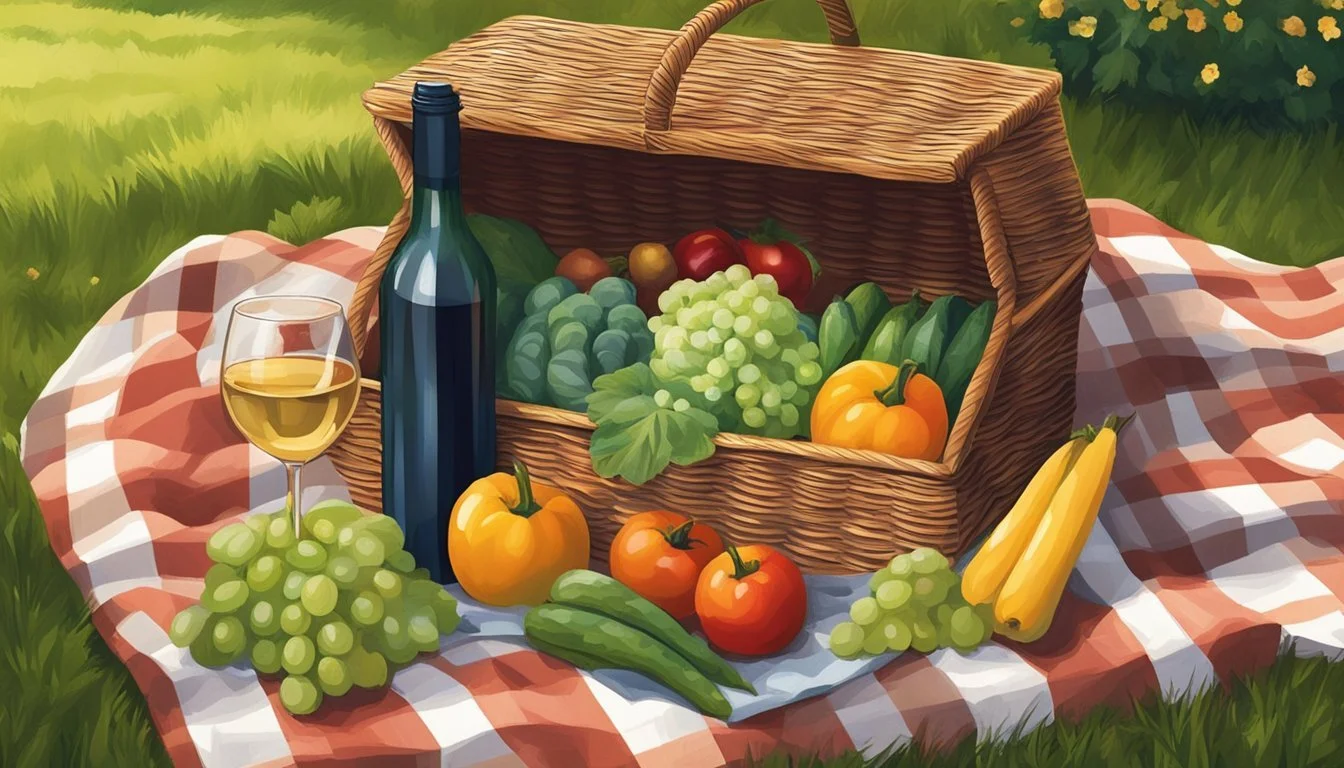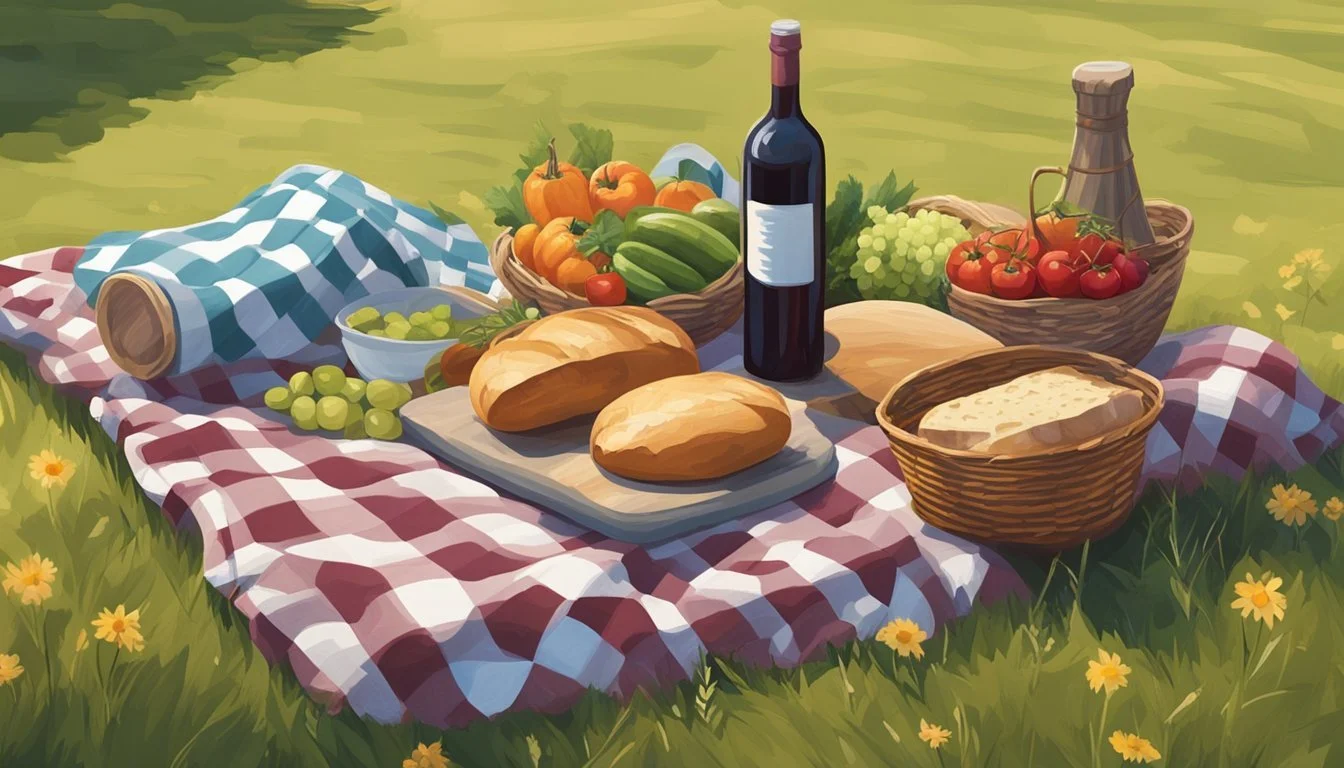How to Create the Perfect Farmers' Market Picnic
Your Guide to a Fresh Feast
Creating the perfect farmers’ market picnic is an exquisite way to enjoy local produce and artisanal goods in a delightful outdoor setting. A farmers’ market offers a treasure trove of fresh ingredients that can transform a simple meal into an al fresco feast. One can find everything from crisp vegetables and ripe fruits to gourmet cheeses and freshly baked bread—all of which are essential components of a memorable picnic.
When planning a farmers' market picnic, selecting a diverse array of foods is crucial. An ideal basket might include pasta salads that make use of the vibrant vegetables on offer, along with a selection of cured meats (What wine goes well with cured meats?) like salami and capicola for a touch of indulgence. Complementing these with a variety of cheeses and crusty bread allows a group to assemble a spread that’s both satisfying and aesthetically appealing. To capture the essence of the locale, pairing these finds with a bottle of regional wine or sparkling water can provide an authentic tasting experience.
Attention to detail can elevate a picnic from pleasant to extraordinary. Farmers’ markets often yield unique finds such as artisanal condiments, homemade preserves, or small-batch sweets that can add a special touch to the outing. Meanwhile, fresh flowers available at many markets can serve as a centerpiece, enhancing the ambience with natural beauty. Considering both the quality of the food and the aesthetics of presentation ensures that the picnic experience is as appealing to the eye as it is to the palate.
Choosing the Right Location
Selecting an ideal location for a farmers' market picnic intertwines comfort with legality and accessibility. One seeks a spot that embodies the summertime spirit while ensuring adherence to local guidelines and providing necessary amenities.
Understanding Local Regulations
Local regulations dictate permissible picnic sites and the scope of activities allowed. Farmers' markets are often situated in areas with specific rules regarding food consumption and waste disposal. It is imperative to check with the market administrators or local authorities to prevent any legal inconveniences.
Assessing Picnic Amenities
A suitable picnic spot should offer:
Shade: To keep temperature levels comfortable during the summer heat.
Seating options: Including benches or grassy areas for picnic blankets.
Waste facilities: Adequate bins for trash and recycling.
These amenities contribute to the overall enjoyment and sustainability of the picnic experience.
Considerations for Distance and Accessibility
When choosing a location, one must evaluate:
Proximity to the market: Ensuring fresh purchases are easily transported to the picnic area.
Accessibility: The location should be convenient for all participants, considering parking and public transport options.
Ensuring a reasonable distance from the market to the picnic spot is crucial for guest comfort and to maintain the freshness of market offerings.
Selecting Your Picnic Essentials
When planning the perfect farmers' market picnic, one must give thought to the items essential for a successful outing. Not only should picnic gear be eco-friendly to honor the spirit of purchasing from local producers, but also prioritize comfort and convenience to enhance the overall dining experience in the outdoors.
Eco-Friendly Picnic Gear
Eco-friendly equipment is paramount for a sustainable picnic. Choose a picnic blanket made from recycled materials to reduce environmental impact. Replacing single-use plastic with reusable containers for food storage is another vital step. One might opt for bamboo or other sustainable silverware options, along with cloth napkins to minimize waste. Utilizing a picnic basket crafted from natural fibers can offer both style and sustainability.
Picnic Blanket: Ideal options are those made of recycled fibers or organic cotton.
Reusable Containers: Glass or BPA-free plastics ensure leftovers stay fresh and are easy to transport.
Silverware: Bamboo or stainless steel cutlery provides durability and reduces reliance on single-use items.
Comfort and Convenience Items
For comfort, consider bringing an easily portable and foldable table for a stable dining surface. Not only does it add to the convenience, but it also keeps food away from ground pests. Packing a picnic basket that aligns with the diner's eco-friendly values without sacrificing functionality is crucial. Items like recycled plastic cups and plates can provide the balance between convenience and environmental consciousness.
Tables: Lightweight and collapsible tables are recommended for ease of carriage and set up.
Picnic Basket: Look for one designed to keep food cool and secure, ideally made from sustainable materials.
Remember, the perfect picnic combines eco-friendly practices with practical items to create a comfortable and enjoyable dining experience.
Planning Your Picnic Menu
Crafting the ideal picnic menu begins with a trip to the local farmers' market. Here, freshness is paramount, as is creating a menu that is thoughtful to dietary needs and reflective of the season's best offerings.
Sourcing Ingredients from the Farmers' Market
When visiting the farmers' market, one should seek out the freshest ingredients for their picnic. Cheese and meat from local farmers can make for a rich and flavorful cheese board complemented by hummus, tzatziki, and crackers or a baguette. Berries, veggies, and leafy greens present colorful and nutritious options. Purchase kale to add a crunchy texture to salads, and select seasonal fresh fruit such as watermelon for a juicy and hydrating dessert.
Creating a Balanced and Seasonal Menu
A balanced picnic menu includes a variety of tastes and textures, catering to both indulgence and health. Start with finger foods such as hard-boiled eggs and pickles. Add a main dish featuring seasonal pork complemented by a side of vibrant salads tossed with fresh veggies. Finish with a sweet touch by incorporating local honey into your dessert or offering a basket of ripe, mixed berries.
Dietary Considerations and Allergies
The picnic planner must be mindful of dietary restrictions and allergies. Ensure there's a variety of gluten-free options like gluten-free crackers or bread. If preparing a cheese board, include dairy-free alternatives. Offer a range of dishes that exclude nuts, eggs, and other common allergens. Clearly labeling food can prevent any mix-ups, allowing all guests to dine with ease and enjoyment.
Beverages for Every Taste
A well-planned picnic beverage selection caters to various preferences, ensuring that both drinkers and nondrinkers can find a refreshing choice suitable for a leisurely afternoon at the farmers' market. It's crucial to consider the balance between alcoholic and non-alcoholic options as well as the practicality of keeping these beverages adequately chilled.
Selection of Wines and Beers
Choosing wines that complement the fresh farmers' market produce can elevate the picnic experience. A crisp, chilled white wine or a light-bodied red, served in shatterproof cups or glasses, is an ideal choice for outdoor dining. When it comes to beer, one can opt for local craft varieties that can be enjoyed by aficionados and casual drinkers alike. Preferably, these should be in cans or plastic bottles for ease of transportation and safety.
Non-Alcoholic Alternatives for Kids and Non-Drinkers
For kids and non-drinkers, having non-alcoholic alternatives is essential. Sparkling water, infused with fruits like strawberries or citrus from the farmers' market, provides a delightful option. One can also prepare homemade zero-proof versions of popular cocktails, such as a strawberry mojito mocktail made with fresh berries, mint, lime, and sparkling water to ensure nobody misses out on the fun.
Keeping Drinks at the Right Temperature
Maintaining the right temperature for drinks is a critical aspect of any picnic. Wine and beer should be kept cool, while non-alcoholic beverages need to stay refreshingly chilled, especially on a warm day. Here are tips for achieving this:
Water and ice should fill approximately 25% of a cooler's volume, with ice packs surrounding the drinks.
Heavier bottles should rest closer to the ice, while lighter, more sensitive non-alcoholic beverages sit on top to prevent freezing.
Chilled drinks should be transferred directly from the refrigerator to the cooler just before departure.
Sustainable Practices
Creating the perfect picnic with sustainability in mind means making choices that support both the environment and the local economy. Here are specific ways to achieve this during your next farmers' market picnic.
Supporting Local Farmers and Artisans
Buying local: Purchasers directly contribute to their community's economy and reduce carbon emissions associated with long-distance food transport. Farmers markets are ideal places to source fresh, seasonal produce and handcrafted goods from local farmers and artisans. By choosing items grown and made within the community, picnickers can enjoy fresher food and support the sustainability of local agriculture.
Benefits:
Fresher produce
Lower carbon footprint
Reducing Food Waste
Composting: Attendees should compost any food scraps to minimize waste. This practice not only reduces the amount of waste in landfills but also creates nutrient-rich soil, which can be used to grow more food. Planning portions carefully can further help in reducing food waste, ensuring that everything purchased at the farmers market is utilized.
Strategies:
Accurate portion planning
Composting organic waste
Avoiding Waste with Reusable Items
Reusable essentials: Instead of relying on single-use items, picnickers should bring reusable utensils, plates, cups, and containers. Items made of recycled materials or sustainable sources serve as eco-friendly alternatives that can be used multiple times. Water bottles, cloth napkins, and glass containers are not only practical but also help keep plastics out of landfills.
Reusable items include:
Plates
Silverware
Cups
Containers
Napkins
Water bottles
Packing and Transportation Tips
Effective packing and transportation are crucial to ensure that food remains fresh and intact during a trip to the farmers' market picnic. It’s important to use the right containers and strategies to avoid any spillage and to make carrying easier.
Keeping Food Fresh
To maintain the freshness of picnic foods, one should start with an insulated bag, at the bottom of which frozen water bottles can be placed to act as coolants. Heavier items that need to stay cold, such as fresh fruits or dairy products from the grocery store, should be stacked on top of the water bottles. One can also bring reusable ice packs, which are an environmentally friendly alternative.
For leftovers: If any food remains after the picnic, ensure it's packed in airtight containers before returning it to the cool bag. This will preserve its freshness and make it safe for consumption later.
Efficient Packing Strategies
When packing items, one should consider both the order of food placement and the best use of space within the basket or cooler bag.
Plates and Utensils: Opting for light and sturdy enamel plates can enhance the picnic experience. They are practical, as they don't collapse under the weight of food, and can easily be recycled after multiple uses.
Food Placement: Begin with the heaviest and most refrigeration-sensitive items at the bottom, working up to lighter, room-temperature items like a bag of chips or bread products.
Ease of Carrying
The choice of containers plays a significant role in transportation ease. A cooler bag for perishables and a durable basket or tote for non-food items are effective.
Carry Comfort: Look for bags with padded straps or a basket with a solid handle to prevent discomfort during transportation.
Organization: Separate food from non-food items to balance the load and minimize the risk of food being squashed.
Using these practical tips, one can ensure their farmers’ market picnic items are transported efficiently and arrive in perfect condition for an enjoyable outdoor meal.
Setting up Your Picnic Area
Choosing the right spot and the setup for a picnic can significantly enhance the experience. A thoughtfully arranged picnic space with appropriate decorations and lighting creates an inviting and comfortable atmosphere for everyone.
Arranging Your Picnic Space
When selecting a location, comfort and spaciousness are paramount. One should look for a level spot with a mix of sun and shade to accommodate preferences throughout the day. Tables, if available, provide a stable surface for food and drinks; however, a large blanket can suffice in a more casual setting. Ideally, the picnic area should be positioned with easy access to the farmers' market for additional supplies if needed.
Decorations and Atmosphere
Decorations can transform a simple picnic spot into a pleasant retreat. Consider using:
Tablecloths or stylish blankets to add color and texture.
Fresh flowers from the farmers' market as centerpieces; they add natural beauty and can be taken home afterwards.
The inclusion of soft cushions for seating can also increase comfort and add to the visual appeal of the space.
Lighting for Evening Picnics
If the picnic extends into the evening, the addition of lighting can maintain the inviting ambiance. Options for lighting include:
Lanterns: They offer a warm, soft light and can be placed around the picnic area for even illumination.
Fairy lights: These can be strung around trees or above the picnic area to create a magical, twinkling effect.
Using LED lights or battery-powered options ensures that the area remains lit without the need for a power source.
Activities and Entertainment
Planning the perfect farmers' market picnic includes a range of activities and entertainment that cater to both kids and adults. These enjoyable elements not only enhance the picnic experience but also provide a glimpse of the vibrant community spirit found at a typical farmers' market.
Games for Children and Adults
Scavenger Hunt: Organize a scavenger hunt where kids search for items commonly found at a farmers' market, like a specific type of fruit or a handmade craft. This entertaining activity keeps children engaged and allows them to explore the market.
Farm to Picnic Blanket Races: Setup relay races where teams must fill their picnic baskets with faux produce before dashing back to their picnic spot.
Trivia: Create a list of trivia questions related to the foods, vendors, and history of the local farmers' market, adding an educational twist to the gathering.
Farmers' Market Bingo: Develop a bingo game centered around items and events typical of a market day, such as spotting a certain type of vegetable or witnessing an impromptu performance.
Music and Live Performances
Farmers' markets often feature a variety of live music and performances, which can serve as the perfect backdrop for a picnic. From solo acoustic guitarists to local bands, the sound of music can elevate the atmosphere, making it more enjoyable for everyone. Introduce guests to the sounds of the market:
Music Schedule: Check out the market's entertainment schedule and plan the picnic accordingly, ensuring guests can enjoy both mealtime and showtime.
Behind-the-Scenes Interactions: Encourage picnic-goers to interact with musicians when possible, offering a behind-the-scenes insight into the local culture and talent present at the market.
Cleanup and Leave No Trace
When planning a farmers' market picnic, attendees should prioritize an eco-conscious approach to cleanup that ensures no waste is left behind, opting for responsible disposal and using recycled materials when possible.
Responsible Waste Management
Compostable Items: Attendees should separate organic waste, such as food scraps, for composting. Utilizing a designated compost bag or container can assist in ensuring these items return to the earth, enriching soil instead of filling landfills.
Recyclables: Individuals must carefully sort any recyclable materials such as glass, aluminum, and certain plastics. Empty and rinse containers to ensure they are accepted in recycling programs.
Non-Recyclable Waste: For waste that cannot be composted or recycled, one should use trash bags made from recycled materials, limiting the environmental footprint.
Packing Up Efficiently
Containers: Efficient packing starts with using reusable containers for food and drink storage. They should be made of durable materials that are not single-use and can be easily cleaned and reused.
Utensils and Napkins: Reusable utensils and cloth napkins negate the need for disposable options. Not only do they reduce waste, but they also add to the aesthetic and experience of the picnic.
Blankets and Tablecloths: Using blankets and tablecloths made of natural fibers, like cotton or wool, ensures that they are durable and potentially biodegradable. Furthermore, they should be shaken out and packed up carefully to avoid leaving any residue behind.
The Farmers’ Market Experience
A farmers' market offers an immersive opportunity for patrons to engage directly with the source of their food and goods. It's an experience that extends far beyond simple shopping, providing education and fostering community connections.
Learning from Local Producers
Patrons have the unique chance to engage with local farmers and artisans, gaining insight into the process of cultivating and crafting their offerings. Conversations at a stall may reveal the intricacies of beekeeping, the careful nurturing required for dairy production, or the methods used to sustainably raise livestock and poultry. These interactions enable consumers to understand the provenance of their food and appreciate the craftsmanship involved in creating textiles and other handmade goods.
Beekeeping: Learn how bees are managed and how honey is harvested.
Dairy: Find out about the milking process and the making of cheese and other dairy products.
Poultry: Discuss the rearing of chickens for eggs and meat.
Textiles: Discover the process from fiber to fabric, often involving natural materials and dyes.
Sampling and Purchasing
Farmers’ markets encourage sampling as a way to taste the freshness and quality of produce before buying. Patrons can savor the burst of flavors from ripe fruits, the freshness of just-picked vegetables, or the richness of artisanal cheeses. The market is not just a venue for transactions, but a place for culinary discovery and supporting local economies.
Taste Test: Indulge in samples from various vendors—finding the perfect ingredients for a picnic.
Buy Fresh: Purchase fresh fruits, vegetables, baked goods, and other local products.
Whether they're engaging with hardworking farmers to learn about sustainable agriculture, or sampling and selecting foods for their next meal, visitors to a farmers' market enjoy an enriching and enjoyable experience.











